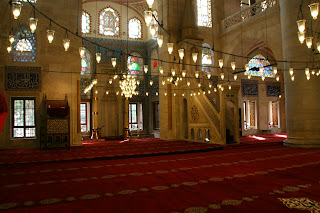 |
| "Hola" from Istanbul. |
 |
Istanbul is a tourist "mecca." In one day you can take in the top four sites: Blue Mosque, Hagia Sofia, Basilica Cistern, and the Topkapi Palace. Here are a few shots of each: |
 |
| Blue Mosque: one of the few mosques in the world to have six minarets. |
 |
| Hagia Sophia: Formerly an Orthodox Basilica, then a mosque, and now a museum. |
 |
| Christian images and Arabic calligraphy, side-by-side. |
 |
| Immense and beautifully illuminated with circular chandeliers. |
 |
| Basilica Cistern: This subterranean cistern provided water for ancient Constantinople. Walkways allow visitors to explore this huge underground area. Very eerie. |
 |
| Topaki Palace: Primary residence of the Ottoman Sultans for 400 years. This place was immense, one room after another. |
 |
| Harem rooms were gorgeously tiled, with comfy lounging areas. |
 |
Ultimately, for us, what makes a trip memorable is wandering down streets, taking in the ambiance and stumbling on unexpected finds. That’s what happened on our second day. |
 |
We decided to walk across a bridge that spanned the Bosphorus Strait to the Asian side of Istanbul. |
 |
We were so proud of ourselves for setting foot in Asia. (We found out later that we were not in Asia; we took the wrong bridge!) |
 |
Not knowing where to go, we just wandered around for a bit. And then, by chance, we found a mosque. It was open with a lone guard, and no one else. The guard encouraged us to enter. |
 |
We took our shoes off at the door (not pictured) and walked on the plush Oriental carpet. The guard turned on the low hanging lights, and we had the place to ourselves. |
 |
| The end to another memorable trip! Hasta luego! |











Beautiful photos as always!
ReplyDelete